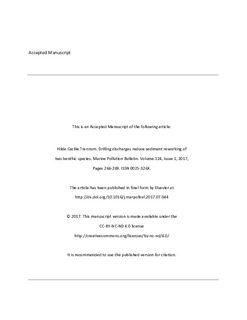| dc.contributor.author | Trannum, Hilde Cecilie | |
| dc.date.accessioned | 2018-09-20T08:47:54Z | |
| dc.date.available | 2018-09-20T08:47:54Z | |
| dc.date.created | 2018-02-27T21:14:41Z | |
| dc.date.issued | 2017 | |
| dc.identifier.citation | Marine Pollution Bulletin. 2017, 124 (1), 266-269. | nb_NO |
| dc.identifier.issn | 0025-326X | |
| dc.identifier.uri | http://hdl.handle.net/11250/2563574 | |
| dc.description | Embargo until 22 July 2019 | |
| dc.description.abstract | Effects of water-based drill cuttings on sediment reworking activity were studied on two important benthic bioturbators (the bivalve Abra segmentum and the brittle star Amphiura filiformis) using thin aquaria, fluorescentdyed sediment particles (luminophores), time lapse photography and image analysis. In the present context, sediment reworking activity was measured as maximum mixing depth and total amount of luminophores transported below the sediment-water interface. There was a significant reduction in the amount of downward transported luminophores in drill cuttings treatments compared to controls with added natural sediments for both species, which also was true regarding maximum mixing depth for A. segmentum. Further, A. filiformis showed a clearly delayed burrowing of luminophores in the drill cuttings treatment compared to control. To conclude, the study showed that water-based drill cuttings have the potential to reduce sediment reworking. Further, it is evidenced that water-based drill cuttings not only cause burial effects. | nb_NO |
| dc.language.iso | eng | nb_NO |
| dc.publisher | Elsevier | nb_NO |
| dc.rights | Attribution-NonCommercial-NoDerivatives 4.0 Internasjonal | * |
| dc.rights.uri | http://creativecommons.org/licenses/by-nc-nd/4.0/deed.no | * |
| dc.title | Drilling discharges reduce sediment reworking of two benthic species | nb_NO |
| dc.title.alternative | Drilling discharges reduce sediment reworking of two benthic species | nb_NO |
| dc.type | Journal article | nb_NO |
| dc.type | Peer reviewed | nb_NO |
| dc.description.version | acceptedVersion | nb_NO |
| dc.source.pagenumber | 266-269 | nb_NO |
| dc.source.volume | 124 | nb_NO |
| dc.source.journal | Marine Pollution Bulletin | nb_NO |
| dc.source.issue | 1 | nb_NO |
| dc.identifier.doi | 10.1016/j.marpolbul.2017.07.044 | |
| dc.identifier.cristin | 1569240 | |
| dc.relation.project | Norges forskningsråd: 164410 | nb_NO |
| dc.relation.project | Norges forskningsråd: 185139 | nb_NO |
| cristin.unitcode | 7464,20,12,0 | |
| cristin.unitname | Marin forurensning | |
| cristin.ispublished | true | |
| cristin.fulltext | postprint | |
| cristin.qualitycode | 1 | |

